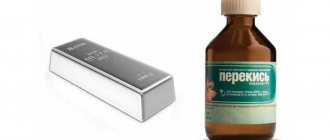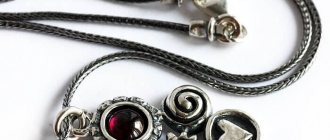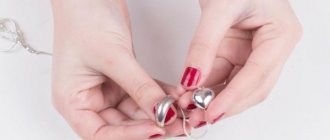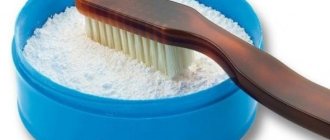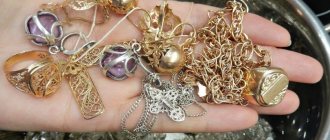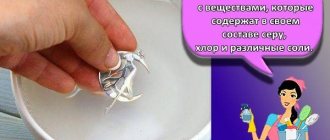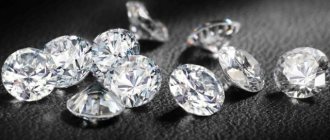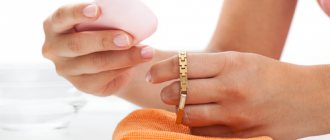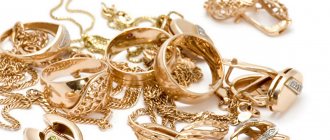Home page » Home and comfort » Caring for jewelry
Author of the article
Svetlana Pavlikhina
Reading time: 5 minutes
AA
Over time, silver darkens and must be cleaned. There are many ways to return products to their original appearance. Most often, silver cleaning is carried out using hydrogen peroxide. The method requires care so as not to damage the metal.
Why can silver turn black?
In fact, there are many reasons why a chain or silver cross on a necklace darkens. The most common ones are:
- natural oxidation processes due to exposure to active chemicals contained in the environment;
- increased air humidity;
- contact with sea water;
- long-term storage of jewelry without wear (a year or more);
- reaction to body sweating;
- contact with household chemicals (for example, when washing dishes or laundry);
- contact of cosmetics, deodorant or perfume on the silver surface.
In order to lighten old jewelry and wash it of plaque that has formed over time, you can use several common methods. However, you always need to start with the main thing: removing fat that appears due to contact with the skin:
- you need to rinse the product under warm water;
- dilute a little liquid soap or mild shampoo in a container;
- using a brush with soft bristles, carefully brush the entire surface of the jewelry, paying special attention to the recesses and fasteners;
- Now you can rinse the product in water and dry thoroughly.
It must be remembered that after cleaning the jewelry should not be worn for 2-3 weeks. This time is enough for the formation of a protective layer on the surface of the product, which helps preserve the silver and protect it from darkening in the future.
Why do silver rings darken and lose their shine?
Ag is a silver-colored precious metal whose ions react with various substances, usually forming a coating on its surface.
The main causes of darkening are:
- interaction with sulfur contained in some medications, human sweat, air and water;
- exposure to aggressive chemicals contained in cosmetics, cleaning products, and detergents;
- the presence of a high percentage of copper in the alloy (the lower the sample, the more copper).
In addition, a silver ring will become dirty if you do not remove it before working in the garden, while cleaning the house, etc. Earth and dust, reacting with human sweat, are rubbed into the metal, both the inner surface and the area where The stone is attached and darkens first.
Articles recommended for reading:
- How to learn fire magic
- Magic amulets and their meaning
- Wiccan magic - the doctrine of the worship of the forces of nature
Superstitious people have their own explanation for this change in the surface of silver jewelry. It is believed that products made from this metal absorb negative energy and thus ward off the evil eye and damage. Of course, this version is far from scientific. In addition, the darkening process is also influenced by taking medications containing sulfur compounds. They are excreted from the human body through sweat and react with metal.
Professional silver cleaning products
These compounds can be purchased at a jewelry store or workshop. You should select the product according to the type of decoration you want to tidy up. You can quickly and effectively clean silver using the following means:
- Apply the compositions in the form of foam to the product, and after 2-3 minutes remove with a soft cloth. They should not be used to clean jewelry that contains organic stones, enamel, or blackening.
- Pour liquid products into a vessel and lower the chain there for 5-7 minutes, then remove and polish with a cloth. Like foams, these products can harm enamel, blackening and stones of organic origin.
- The Aladdin solution will do an excellent job of removing darkening of silver if you dip a chain or ring into it for 15 seconds. Then clean the product with a napkin. This product should not be used on stones or enamel.
- The “Talisman” set, consisting of paste and napkins, will clean even very old products. To clean silver from blackness with this product at home, you need to apply the composition to the jewelry and then polish it.
After you have cleaned your chain or ring with any of these products, they should be rinsed under running water and dried. And to protect the skin of your hands while working, you should wear gloves.
Ready-made silver reading products
In addition, silver products can be taken to a jewelry workshop, where a master will clean the jewelry using professional means and methods.
How to clean silver if you can’t afford store-bought products? Use traditional methods.
Preparing silver items for cleaning
Over time, a black coating appears on silver jewelry.
Silver is a popular and inexpensive metal that is used in jewelry workshops to make cutlery. Items made from a pure component are difficult to find; an alloy with copper is usually found. 925 purity means 92.5% silver and 7.5% copper were used.
Silver and added impurities easily enter into chemical reactions with sulfur, which is found in the air and human sweat. The speed of blackening of products is also affected by:
- the presence of strong oxidizing agents;
- high humidity;
- high ambient temperature.
The more impurities a product contains, the more susceptible it is to oxidation. Therefore, cutlery needs more frequent and thorough cleaning than jewelry.
If you are cleaning silver at home for the first time, follow these tips:
- Find out the sample . The choice of products suitable for cleaning the product will depend on the percentage of silver and impurities. Possible types of samples: 720, 800, 875, 916, 925, 960, 999.
- Degrease the item . Over time, a transparent film forms on jewelry. To remove it, you need to soak the products in a soapy solution. You can use shampoo or dishwashing gel.
To carry out the procedure for cleaning jewelry or dishes, you can use soft-bristled brushes, sponges, and cotton napkins. If you clean silver with dry powders or metal brushes, you can leave microcracks and scratches.
If the jewelry contains a precious stone - pearls, coral, amber - such items should not be dipped in boiling water. Inserts may fade or crack. Sapphire, emerald, and aquamarine are not afraid of heat treatments.
How to clean a silver chain with baking soda
If you carefully care for your jewelry and do not allow heavy deposits to form, you can use the gentle dry cleaning method. To do this, you will need a paper towel or napkin and baking soda, which perfectly cleans many types of household stains.
When you have prepared everything you need, you can get to work. To manually clean your silver, do the following:
- Spread a paper towel on a flat surface.
- Pour baking soda onto the paper, spreading it evenly over the napkin.
- Place the decoration on top of the powder and wrap it in a napkin.
- Gently rub the chain wrapped in a paper towel using the same motions as when hand washing. Pay special attention to the part of the decoration where the darkened areas are located.
- Hold the softened tissue between your fingers and gently clean the blackened chain by pulling it through the paper and wiping.
When finished, remove the soda using a piece of soft cloth. If particles of the substance remain after this, it is permissible to rinse the jewelry in warm water.
Other cleaning methods
There are safer ways to clean the surface of silver items:
- solution based on tooth powder;
- composition of ammonia and white chalk;
- a mixture of soda, food foil, water;
- soap solution;
- a mixture of vinegar and citric acid;
- cleaning with GOI paste.
See below how you can clean silver with ammonia or ammonia:
How to clean silver using baking soda and foil
Cleaning with soda and foil is considered the best among those carried out at home. It does not require a lot of time, effort, and, importantly, finances.
But you should be aware of some limitations when working with soda, as well as other abrasive substances (for example, salt):
- Do not clean very smooth products so that minor damage does not remain on them;
- It is best to clean jewelry with small details, cutouts and designs;
- unlike precious stones and fionites, which should not be exposed to such influence, silver items with pearls tolerate the procedure well;
- You should not add vinegar to soda, which can cause a lot of damage to jewelry.
This option for processing jewelry allows you to quickly remove dullness and darkening. In addition, this method can be used to clean not only jewelry, but also dishes. You just need to make sure that there are no precious stones on the jewelry.
The essence of the method is that when a silver surface is treated with foil with the addition of soda, a small charge of electricity appears on the surface, which has a destructive effect on dirt and allows you to remove darkening.
There are four types of application of this method:
- Cover a deep container with foil, then place the silver in it and cover it with soda. Now you just need to add boiling water to this bath. After the reaction is over, remove the jewelry. Alkaline bubbles will completely remove all darkening.
- Another method involves boiling 0.5 liters of water and 2 tablespoons of soda in a solution. After five minutes, you can put the silver in there, laying it down with foil, and it should lie in this container for 5 minutes. Now clean the products using a soft cloth.
- The third option involves pouring soda and salt into a container with foil, adding a little liquid soap. The products should be filled with hot water and left for 5 minutes. With the help of soda, the plaque will dissolve, and the product will shine as before.
- You can clean old silver using soda like this: put foil in a pan; place silver items on it; Dissolve baking soda and salt in boiling water and pour into a saucepan; the interaction of foil with baking soda will soften the darkening, after which it will easily come off.
You can carry out such cleaning without worrying about your jewelry as needed.
General information
Types and causes of pollution
Improper storage or wearing of silver jewelry can cause the item to turn yellow or black. The main reasons include: increased humidity, contact with cosmetics on jewelry; exposure to cleaning agents, resulting in a silver reaction.
How does peroxide work on blackened silver?
Hydrogen peroxide is a colorless substance and is considered the safest for silver and gold. However, the more additives made of base metals in a product, the higher the risk of blackening the jewelry during cleaning.
Important : before carrying out the cleaning procedure, you should make sure that the method will not damage the product; you must apply a small amount of the composition to the inside of the jewelry. If the metal has brightened, then the procedure can be repeated with the entire decoration
Advantages and disadvantages
Cleaning with hydrogen peroxide is a popular method; it quickly and effectively removes dark deposits from jewelry. After the procedure, the product regains its shine, brightness and light shade.
The disadvantages include:
- - with a large number of additives made of base metals, the jewelry will blacken even more;
- — requires care; jewelry damaged by hydrogen peroxide cannot be restored.
Important : the higher the standard of silver jewelry, the safer it is to use this cleaning method.
What is not recommended for cleaning silver?
Some objects and substances can harm precious metal. These include:
- - abrasive substances, soda, salt that are not dissolved in water;
- - hard brushes and sponges;
- - soaps and powders in highly concentrated form.
How to clean silver with hydrogen peroxide
If you are going to use hydrogen peroxide (peroxide) to clean silver, then you need to know for sure that there are no impurities of any other substances in it and that this is really silver, and not cupronickel or simple metal.
Since if they are present, a chemical reaction is possible and as a result, streaks and stains will appear on your jewelry, which will be quite difficult to remove. Most likely, you will have to contact specialists.
Before you start cleaning your silver, be sure to test it in an inconspicuous place. Soak a cotton swab in peroxide and gently apply to the product. If the surface is not damaged, then the entire product can be processed. Hydrogen peroxide will whiten the jewelry and give the silver a natural shine.
- Cleaning silver with hydrogen peroxide is done as follows: soak the desired items in 3% peroxide and wait a while until the dark coating comes off. Then rinse the metal in clean water and wipe dry.
- Take 100 ml of hydrogen peroxide 3% and 100 ml of ethyl alcohol. Mix and place the contaminated decoration or cutlery into the resulting solution. If it is a chain or bracelet, you need to keep it in the liquid for 20 minutes. If you are cleaning rings, massive earrings, cutlery, you will need to wait for about an hour. But do not leave the products unattended, watch the process so that you can react in time if something goes wrong. When the exposure time has expired, thoroughly wipe the metal with a flannel cloth.
- It is necessary to take equal parts of ammonia, peroxide and liquid baby soap. Add all this to a glass of clean water and stir thoroughly. Immerse your silver items in the resulting liquid and leave for 15 minutes. After the time has passed, remove the jewelry, rinse well in warm water and wipe dry with a wool or flannel cloth.
Caring for jewelry with stones
After cleaning, silver with stones should be polished with a soft cloth.
Chains, pendants, rings with stones should be treated with professional products purchased in the store. Traditional methods are not suitable for washing such jewelry. Using industrial solutions, you don’t have to worry about the stone becoming dull or losing its shine.
If it is not possible to purchase the product, ammonia will do. Add 5-6 drops of alcohol to 200 ml of water. Dip the decoration into the solution, leave for 3-5 minutes, rinse with clean water.
After washing, the jewelry must be polished with a piece of flannel or suede.
Rules for cleaning silver using ammonia
Ammonia is considered one of the best means for removing plaque, dirt and discoloration. The reason is that ammonia is also an excellent solvent, which allows it to easily cope with complex silver stains.
During the cleaning process, the substance reacts with oxidizing agents (remember, they are the main cause of plaque formation), and as a result of exposure they are converted into ammonium salts. The metal cannot be harmed; ammonia is completely safe for it. In addition, this substance is highly volatile and quickly evaporates from the surface of silver.
The main thing is to follow a simple rule when working with ammonia, namely, do not soak jewelry in it for a long time. As a result of prolonged exposure to the chemical, the metal may change its color, for example, turn yellow.
Ammonia will do an excellent job of removing stains and deposits on silver without harming either the metal or your health if used correctly. How to clean silver with ammonia? Please note the principles of working with caustic compounds:
- during the cleaning process, protect your hands with gloves and your respiratory system with a medical mask, since ammonia has a caustic structure and a pungent odor;
- clean silver jewelry separately from items made of other metals, otherwise alloys of different densities and properties will undergo an unpredictable chemical reaction under the influence of ammonia (for example, silver may become yellow, and gold purified together with it may become white or pink);
- When cleaning, do not use rough, hard sponges; it is better to use a soft cloth, foam rubber, and in case of severe contamination, an old toothbrush;
- if the product has not darkened much, limit yourself to cleaning in a weak soap solution, and save ammonia for more serious stains;
- if there are stones on the jewelry, it is necessary to reduce the percentage of ammonia in the cleaning solution (no more than 5 drops per 200 ml of water), in addition, only durable and chemical-resistant stones, for example, diamonds, can be cleaned in this way;
- when stones are glued to metal, avoid cleaning methods that involve soaking the product in ammonia-based products, since this composition is a solvent and easily neutralizes the glue, as a result of which the stones will simply fall off;
- Do not use ammonia on items containing pearls or on gold-plated silver.
If you are not convinced that you can do everything correctly, or are not able to determine the origin of the stones on the product, it is better to seek professional help, excluding any experiments at home.
You can clean silver at home using ammonia according to one of these recipes:
- Aqueous solution of ammonia. Prepare a cleaning composition by mixing ammonia with water in a ratio of 1:10. Place decorations in this mixture; the time they remain in the solution depends on the degree of contamination. If the plaque is insignificant, 15 minutes will be enough, and if there is severe oxidation, the product can be kept in this liquid for up to 30 minutes. Then remove the silver from the ammonia solution, rinse under running water and wipe dry.
- Ammonia, chalk and soap. Make a weak soap solution and place the jewelry in it for 5-7 minutes. At this time, start preparing the cleaning paste, mix crushed chalk and ammonia so that you get a “gruel”. Remove the items from the soap solution, apply the paste to the silver, and when it hardens, rinse off the mixture and polish the item with a soft cloth.
- Ammonia and tooth powder (can be replaced with paste). The solution is prepared in the proportion of 2 parts ammonia to 5 parts water and 1 part powder or paste. The product must be mixed thoroughly, and then applied to the jewelry and cleaned off the remaining plaque and dirt. Afterwards, remove the composition under running water and wipe the silver with a soft cloth.
The last method of cleaning silver with ammonia is used for severe contamination, and it is also good for cutlery made of this metal. But it is strictly prohibited to treat products with stones with this composition.
If for some reason the listed methods do not suit you, and you do not want to contact a specialist, or do not have such an opportunity, you can use another cheap and safe recipe for cleaning tarnished silver with ammonia.
To carry out the work you will need:
- ammonia;
- hydrogen peroxide;
- filtered water.
To get your jewelry in proper shape, follow these instructions:
- Mix the ingredients in equal parts until a homogeneous mass is formed.
- Place the decorations in a container with the solution and leave until the plaque can be easily cleaned off or disappears on its own. However, remember that you can keep jewelry in ammonia for no more than 30 minutes.
- Remove the product and, if necessary, clean hard-to-reach areas or areas of particularly heavy dirt with a cotton swab.
- Rinse the silver in plenty of running water.
- Polish the surface using a soft cloth.
Do not forget that cleaning with “soaking” of products is best done only if the decoration does not have stones on the surface.
Precautions when working with ammonia
When working with ammonia, you must remember the caustic nature of the composition and take appropriate precautions:
- protect your face and hands from aggressive composition using gloves and a mask;
- use tweezers to place objects in the solution and then remove them;
- do not lean over the vessel with the cleaning solution, this can cause burns to the mucous membranes and chemical poisoning;
- work with ammonia only in a well-ventilated area, with open windows;
- If the composition comes into contact with unprotected skin, immediately rinse the area with plenty of running water.
Preparation
Before you start cleaning an item with hydrogen peroxide, you need to prepare it for washing. The first step is to remove the layer of dirt and grease that has accumulated in areas with relief. To do this, make a soap solution and leave the decoration in it for 3 hours.
Then they check whether the peroxide will harm the metal. To do this, apply a drop of the product to the lock of the product or the inside; if the dirt has been cleaned well, you can begin treating the entire surface.
Precautionary measures
When working with the product you should:
- put on rubber gloves;
- do not inhale the cleaning solution;
- Do not drip onto furniture or clothes, as stains will remain.
The product itself does not cause skin burns and does not harm the environment.
You need to work especially carefully when adding ammonia to the solution.
Can the product damage silver?
Peroxide can ruin a silver item. Before use, you should make sure that the item is made of a high-grade alloy. The higher the amount of impurities, the greater the likelihood that the metal will become even darker.
925 purity means that 92.5% is silver, and 7.5% is various impurities that ensure durability and quality. The lower the sample, the worse the item behaves when in contact with hydrogen peroxide.
Low-quality jewelry and silver-plated cutlery cannot be cleaned with peroxide. You can only rub them with a dry cloth or use jewelry napkins.
How to prevent tarnishing of silver
To ensure that silver jewelry does not darken and remains attractive for a long time, the following rules must be followed:
- Store products separately from each other, in boxes, fabric bags or wrapped in soft flannel or wool rags.
- It is advisable to polish the jewelry every day using a piece of flannel.
- Remove jewelry before visiting beaches, swimming pools, saunas, as well as when applying creams and masks to the skin.
- When washing or cleaning, it is also better to put the accessories in the box, since fumes from washing powders, cleaning agents and detergents contribute to the appearance of plaque.
- If you have to take medications in courses, it is better to part with silver jewelry during this time. The fact is that some medications promote profuse sweating, as a result of which the metal quickly darkens upon direct contact with the skin.
- Once every 2 months it is necessary to clean silver using professional or folk remedies.
As is clear from the above, cleaning silver yourself is not difficult. But if the jewelry contains stones or enamel, it is better not to risk it and entrust this work to a specialist.
Silver occupies a special niche among other metals used to create jewelry. It has exquisite beauty and durability, allowing you to enjoy the products for many years and even pass them on from generation to generation.
Prevention of blackness on silver
Earrings, rings, and chains made of silver can retain their aesthetic appearance longer and not turn black if you follow the rules of caring for them.
Prevention of metal blackness:
- store silver jewelry in a place separate from other items;
- the room should be dry;
- do not keep objects in the sun;
- Do not use rough sponges for cleaning;
- select boxes and storage boxes that do not contain sulfur; cardboard and viscose silk are also not suitable;
- remove jewelry before cleaning, taking a bath or shower;
- the hair dyeing procedure can negatively affect the metal, so it is advisable to remove the earrings and chain;
- To regularly care for your jewelry, you can use a soap solution and a toothbrush;
- For long-term storage, silver is wrapped in foil.
Self-cleaning silver from blackness at home is possible if you know the main points and characteristics of the metal. After cleaning jewelry, it is recommended to follow the storage conditions so that they do not lose their shine.
Recommendations
Hydrogen peroxide fumes are harmful to the respiratory system, so it is advisable to clean them in a well-ventilated area or in the air, for example, on a balcony. The same applies to ammonia, which has an extremely pungent and unpleasant odor.
To prepare solutions, you must use a glass or plastic rod, and never use your bare hands. It is better to manipulate the product in solution with tweezers.
After the described cleaning procedure, the jewelry will again acquire its shine and its inherent matte shine. And with a gentle wear regime, which implies minimal contact of silver with cosmetics, household chemicals, hot water, etc., the next cleaning will not be needed soon.
Nuances of removing certain contaminants
There are impurities that appear only on precious metals, for example, horn silver. To get rid of it, you should pay special attention to the types and causes of contamination.
Black
Blackness is the most common contaminant of precious metals. To get rid of it, you can rub the product with soda, soak it in a saline solution, clean it with lipstick, an eraser or olive oil. The vinegar removal method is also effective.
Dirt
Soap infusion will become an indispensable bleach. You need to grate the soap, dissolve it in water, let the product sit for 30 minutes, then rinse and dry.
Yellowness
One of the most common types of stains. Yellowness may appear even after going to the pool. The reasons for its appearance are the organic reaction of chlorine and iodine. To remove yellowness, you need to put the decorations in a solution with raw potatoes. You can also remove stains with baking soda, olive oil, toothpaste or soap solution.
Iodine
Raw potatoes, soap solution, soda, salt, toothpaste will help destroy iodine stains. You can also use foil envelopes.
Burn
Grind 1 potato, place the potato pulp with juice in a separate bowl. Place items there and leave for 2-3 hours. Afterwards rinse with water.
After hydrogen sulfide
“Foil envelopes,” as well as salt and soda solutions, will help restore shine and whiteness after hydrogen sulfide. Housewives also note the effectiveness of tooth powder.
Horny plaque
A dull, purple tint to jewelry or coins indicates the appearance of horn silver. When processing such things, you need to be extremely careful or contact specialists, since the risk of irretrievable loss is too great. Add ammonia with a concentration of 5% to the water bath, remove it after 5-10 minutes, wipe with a sponge or a special brush. Then rinse and dry.
How to choose a method
There are two types of removal of plaque from precious metals: home and professional.
To clean silver, it is enough to audit the available means at hand and choose the most optimal method. The use of aggressive methods of influence is carried out only on the coarsest alloys and simple decorations, so as not to damage them. Complex, expensive items with stones and engravings require a careful approach. The choice of method is influenced by the sample size of the product, weight, the presence of complex elements (gilding, stones, engraving) and the degree of contamination.
The lack of effects from home methods or difficult cases lead housewives to professional cosmetics, which can be purchased with specialized mixtures and pastes for removing stains from silver.
Home methods
Housewives often choose home methods for cleaning silver due to the simplicity and availability of folk recipes, as well as the ecology of the selected products, which do not leave chemicals on precious metals.
Soda
Using baking soda is one of the effective ways to clean the kitchen. It also works well to remove tarnish on silver.
- Pour liquid soda until a slurry appears, apply it to a sponge or cloth and clean the products until the plaque is removed. Then rinse thoroughly to remove stains. At the same time, you need to be careful with matte and smooth objects; traces of soda may remain.
- Dilute 2 standard spoons of soda per half liter of water solution. Wait until it boils, remove from heat, place things in a container. You also need to add a piece of foil there. After 10-20 minutes, remove the products and rinse.
Soda baths and boiling are often used when processing not only silver, but also gold.
Foil
Cut kitchen foil into medium squares and add a teaspoon of moistened baking soda to the middle of each square. Then put things in and cover with foil to make an envelope. Throw into boiling water for 10-20 minutes, remove, cool, and then rinse and wipe with a special cloth.
Ammonia
The effectiveness of ammonia has been proven by more than one generation of housewives and jewelry lovers. To remove plaque, just take 2 standard spoons of the specified alcohol, dilute it with a liter of water, then put all the Argentum things into the resulting solution. Another way is to add a teaspoon of hydrogen peroxide and a drop of detergent to the existing solution. Immerse the products in it for 10-20 minutes and then rinse.
Blackening of a silver chain and methods for cleaning it
Hydrogen peroxide
One of the aggressive treatments is suitable for simple, low-grade items. Dilute peroxide at 3% concentration in a warm water bath. Place all darkened metals there. After 5 minutes, remove and rinse and dry. When working with peroxide, you should wear gloves to avoid getting burned.
Vinegar
Pour vinegar (3 percent solution) into a deep plate. Then heat the silver items a little and lower them into the liquid. After 15 minutes, remove and rinse in distilled liquid and polish. If there is no specified percentage of vinegar, you can take a 6% solution and dilute it with water.
You can also wipe with a cloth soaked in vinegar, but to achieve effectiveness, it is better to immerse it in heated water.
Tooth powder and paste
Teeth whiteners are great for cleaning cutlery. The paste removes sulfide film well. You can take a small amount of paste, a soft toothbrush or cloth and rub gently.
Lemon acid
An aggressive substance that can even harm silver. If used correctly, this is impossible. You need to dissolve 100 g of dry acid per half liter of liquid. At the same time as the silver items, throw in a copper wire (a small piece) and heat it in a steam bath. After 15 minutes, remove and rinse with distilled liquid. Then polish it.
Other acid
Formic acid, like other acids, can be used in the processing of silver. Dilute formic acid at 5% concentration in a warm water bath. Leave for 5 minutes, rinse and dry.
Salt
Pour two tablespoons of salt into half a liter of liquid. Drown everything blackened in the solution and leave for 2-3 hours or bring to a boil in 20 minutes. Then rinse and dry
Coca Cola
The famous lemonade has long been used to remove dirt and clean dishes. The drink is also effective in purifying precious metals. Place the products in a container filled with sizzling liquid for 20 minutes. Another way is to bring the drink to a boil and put silver in it for 15-20 minutes.
Potato
An effective folk method is peeling potatoes. Grind a couple of potatoes until a paste forms, add water to the resulting mixture and soak for 10-15 minutes. Afterwards, strain the solution and immerse objects in it for 20 minutes.
This method works well for minor stains.
Olive oil
Olive oil is used when you need to clean expensive silver items with a slight coating. Apply a little oil to cotton wool or a cloth and wipe the stained areas on the products with it. This method is only suitable for minor darkening; in other cases, the oil may not cope.
Eraser
The eraser is used as the last stage of cleaning, for example, after boiling or treating with soda. Using an eraser, simply erase the remaining stains on the products until they disappear completely.
Boiling
Boiling is used for deep contamination when other methods do not work. Most often, soda and salt solutions, as well as foil, are used for boiling. Some housewives add household chemicals.
To boil, take 2 tablespoons of baking soda, 2 tablespoons of salt, and a little dishwashing detergent. Place all this in a saucepan and add 0.5 liters of water. Bring the solution to a boil, and then place silver items in it. After 5 minutes, remove, rinse and wipe dry.
Chalk
The chalk is crushed and mixed with ammonia. The resulting mixture is applied to the silver with a brush or sponge and rubbed until the plaque is removed.
Egg
Place the decorations in the liquid in which the eggs were previously boiled and leave for 15-20 minutes. Take it out and wipe it with a cloth.
Take a raw egg, separate the yolk from the white, then soak the yolk in cotton wool and wipe things with it. Leave in the yolk for a while and then rinse.
Ash and ashes
Dip a damp cloth into ash or ash and apply it to things, then rub with ash until dirt and stains are completely removed. Then rinse and dry.
Curdled milk
Place silver items in regular yogurt and leave for 20 minutes. Then rinse and dry.
Ketchup
Place things in ketchup for 15-20 minutes, take a sponge or cloth and wipe all hard-to-reach places, as well as dirt. Leave for another 5-10 minutes. Then wash in soapy water and polish.
Lipstick
No matter how paradoxical it may sound, lipstick cleans small objects well: rings, earrings, pendants. Apply lipstick to a napkin or cloth, then wipe the jewelry with it, then rinse thoroughly.
Cosmetic powder
Regular women's powder cleans silver items well. You need to pour a little powder onto a cloth and rub the jewelry with it until the stains disappear. This method is well suited for small silver jewelry.
Cleaning blackened silver
